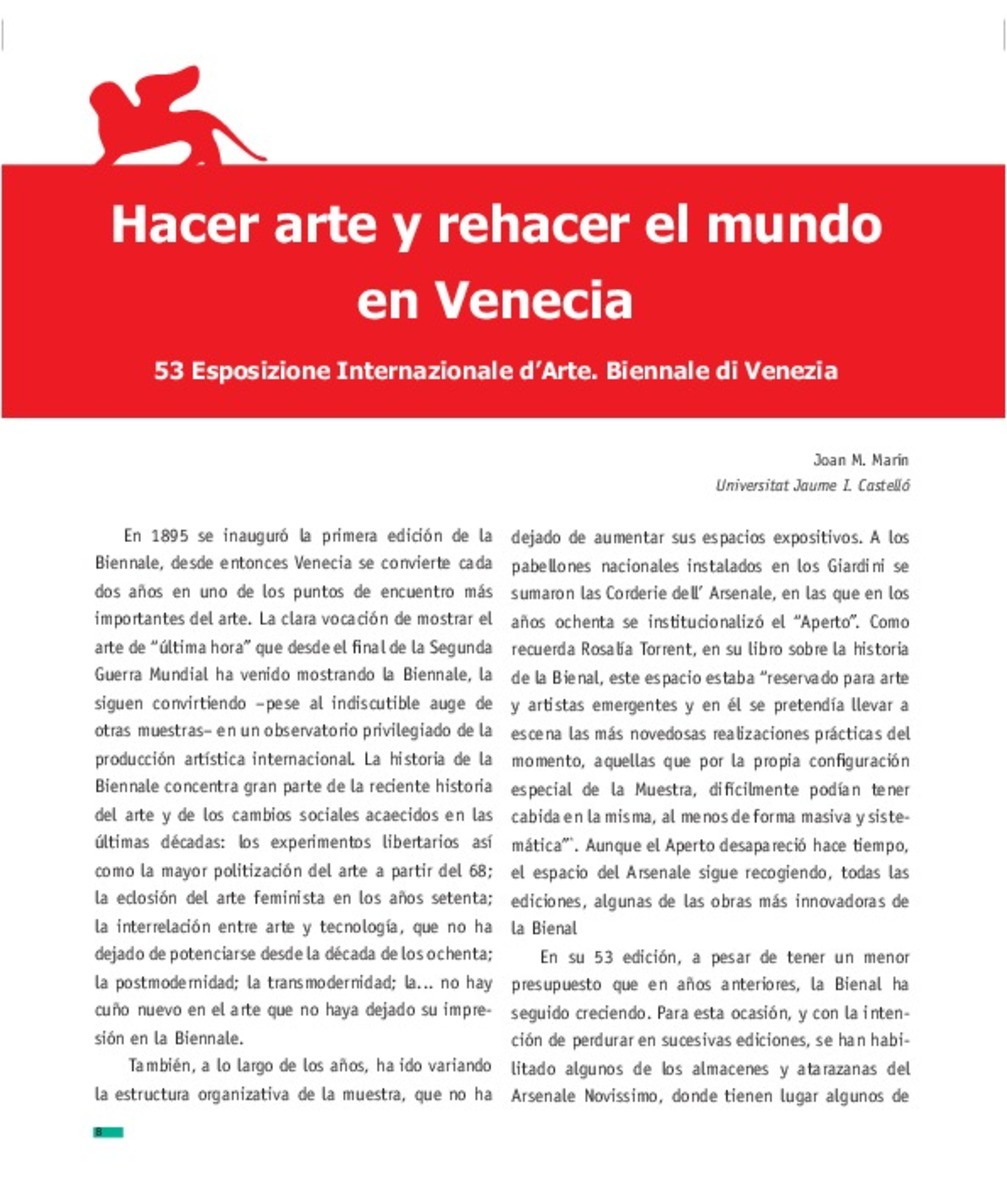Mostrar el registro sencillo del ítem
Hacer arte y rehacer el mundo en Venecia: 53 Esposizione Internazionale d’Arte. Biennale di Venezia
| dc.contributor.author | Marín Torres, Juan Manuel | |
| dc.date.accessioned | 2012-04-19T23:21:40Z | |
| dc.date.available | 2012-04-19T23:21:40Z | |
| dc.date.issued | 2009 | |
| dc.identifier.citation | CBN: revista de estética y arte contemporáneo (2009), año 1, no. 1, 8-25 | |
| dc.identifier.issn | 1888-9719 | |
| dc.identifier.uri | http://hdl.handle.net/10234/34920 | |
| dc.description.abstract | En este artículo el autor analiza la 53 edición de la Biennale di Venecia. Venecia se convierte cada dos años en uno de los puntos de encuentro más importantes del arte. La clara vocación de mostrar el arte de “última hora” que desde el final de la Segunda Guerra Mundial ha venido mostrando la Biennale, la siguen convirtiendo – pese al indiscutible auge de otras muestras – en un observatorio privilegiado de la producción artística internacional. Sin duda, la Biennale continúa siendo un macro-acontecimiento artístico; al Palacio de las Exposiciones y a los treinta históricos pabellones ubicados en los Giardini, hay que sumar otra treintena de pabellones nacionales diseminados por toda Venecia en iglesias, ex-conventos y palacios renacentistas. Además, paralelamente al desarrollo de la muestra, se realizan casi cien exposiciones y eventos artísticos colaterales. En total, no menos de setecientos artistas exponen sus obras | |
| dc.description.abstract | In this article the author analyses the 53rd Venice Biennale Art Exhibition. Every two years Venice becomes one of the most important meeting points in the art world. Since just after the Second World War, the Biennale’s aim has been to show off "what’s hot” in art and this, despite the undeniable growth of other exhibitions, has enabled it to remain a privileged observatory of what is being produced on the international artistic scene. Without a doubt, the Biennale is still an artistic macro-event. In addition to the Palazzo delle Esposizioni and the thirty historical pavilions located in the Giardini, there are also another thirty national pavilions spread throughout the whole of Venice in churches, ex-convents and renaissance palaces. Furthermore, and in parallel to the show itself, there are almost a hundred “fringe” exhibitions and artistic events. Altogether, no fewer than seven hundred artists put their work on show | |
| dc.format.extent | 17 p. | |
| dc.format.mimetype | application/pdf | |
| dc.language.iso | spa | |
| dc.publisher | Collblanc | |
| dc.rights | © Collblanc | |
| dc.rights.uri | http://rightsstatements.org/vocab/InC/1.0/ | * |
| dc.subject | Biennale di Venecia | |
| dc.subject | 53 edición | |
| dc.subject | Exposición internacional de arte | |
| dc.subject | Arte | |
| dc.subject | Artistas | |
| dc.subject | S. XXI | |
| dc.subject | Arte actual | |
| dc.subject | Venice Biennale | |
| dc.subject | 53rd edition | |
| dc.subject | International art exhibition | |
| dc.subject | Art | |
| dc.subject | Artists | |
| dc.subject | 21st century | |
| dc.subject | Modern art | |
| dc.subject.lcsh | Art, Modern--21st century--Italy--Venice--Exhibition | |
| dc.subject.other | Biennale di Venezia (53a : 2009) | |
| dc.subject.other | Art modern--S.XXI--Itàlia--Venecia-- Exposicions | |
| dc.title | Hacer arte y rehacer el mundo en Venecia: 53 Esposizione Internazionale d’Arte. Biennale di Venezia | |
| dc.type | info:eu-repo/semantics/article | |
| dc.rights.accessRights | info:eu-repo/semantics/openAccess | |
| dc.relation.publisherVersion | http://collblanc.es/Collblanc/Revista_files/CBN_01.pdf | |
| dc.type.version | info:eu-repo/semantics/publishedVersion |
Ficheros en el ítem
Este ítem aparece en la(s) siguiente(s) colección(ones)
-
IF_Articles [319]
-
HIS_Articles [442]
Articles de publicacions periòdiques







